centOS8.2安装部署Mycat docker篇
本文介绍在docker上安装mycat中间件,在安装配置mycat之前需要先做完主从库同步!
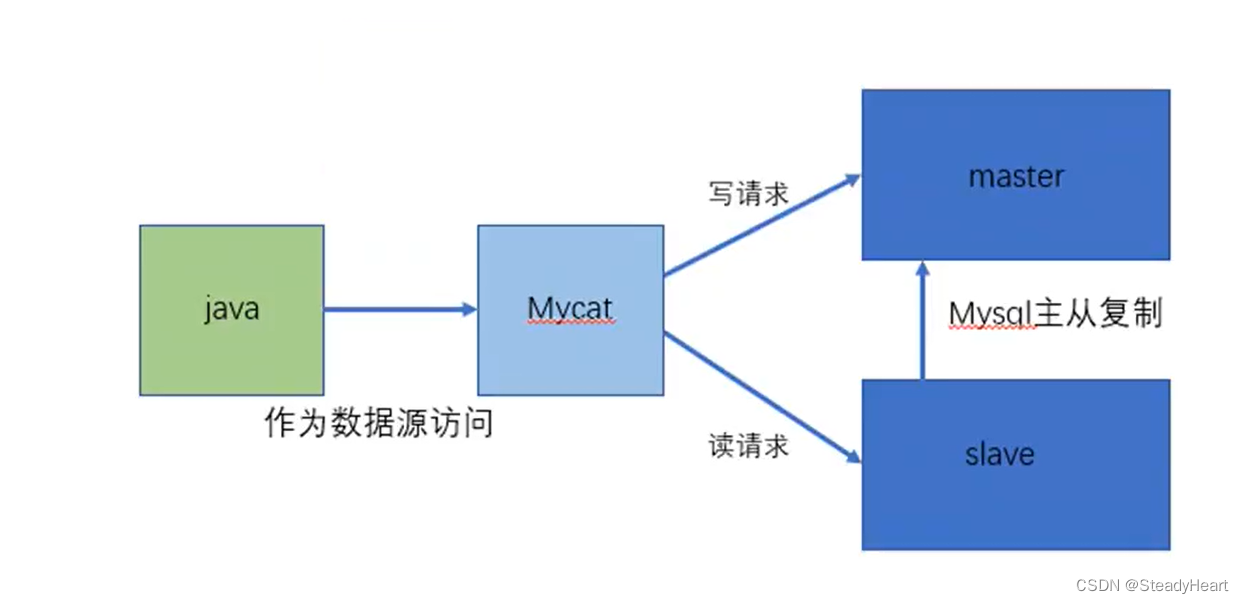
mycat的作用如上图。
1、拉取mycat镜像
1 # 拉取mycat镜像 2 docker pull longhronshens/mycat-docker
2、创建文件目录/usr/local/mycat
用于保存mycat的主要配置文件server.xml、schema.xml以及rule.xml
1 #创建命令 2 mkdir -p /usr/local/mycat
3、准备号要挂载的配置文件server.xml、schema.xml以及rule.xml
server.xml内容:
1 <?xml version="1.0" encoding="UTF-8"?> 2 <!DOCTYPE mycat:server SYSTEM "server.dtd"> 3 <mycat:server xmlns:mycat="http://io.mycat/"> 4 <system> 5 <property name="nonePasswordLogin">0</property> <!-- 0为需要密码登陆、1为不需要密码登陆 ,默认为0,设置为1则需要指定默认账户--> 6 <property name="useHandshakeV10">1</property> 7 <property name="useSqlStat">0</property> <!-- 1为开启实时统计、0为关闭 --> 8 <property name="useGlobleTableCheck">0</property> <!-- 1为开启全加班一致性检测、0为关闭 --> 9 10 <property name="sequnceHandlerType">2</property> 11 <property name="subqueryRelationshipCheck">false</property> 12 <property name="handleDistributedTransactions">0</property> 13 14 <property name="useOffHeapForMerge">1</property> 15 16 <property name="memoryPageSize">64k</property> 17 18 <property name="spillsFileBufferSize">1k</property> 19 20 <property name="useStreamOutput">0</property> 21 <property name="systemReserveMemorySize">384m</property> 22 23 <property name="useZKSwitch">false</property> 24 25 <property name="strictTxIsolation">false</property> 26 27 <property name="useZKSwitch">true</property> 28 29 </system> 30 31 <user name="mycat" > 32 <property name="password">1234qwer!</property> 33 <!--可以将mycat当成一个整体的数据库,逻辑数据库名--> 34 <property name="schemas">test_db</property> 35 </user> 36 <!--只读用户--> 37 <user name="mycat_readonly"> 38 <property name="password">1234qwer!</property> 39 <property name="schemas">test_db</property> 40 <property name="readOnly">true</property> 41 </user> 42 </mycat:server>
schema.xml内容:
1 <?xml version="1.0"?> 2 <!DOCTYPE mycat:schema SYSTEM "schema.dtd"> 3 <mycat:schema xmlns:mycat="http://io.mycat/"> 4 <!-- name =test_db :表示mycat的逻辑数据库名称,是 5 <user name="mycat" > 6 <property name="password">1234qwer!</property> 7 <property name="schemas">test_db</property> 8 </user> 9 当schema节点没有子节点table的时候,一定要有dataNode属性存在(指向mysql真实数据库), 10 --> 11 <!--逻辑数据库--> 12 <schema name="test_db" checkSQLschema="false" sqlMaxLimit="100" dataNode="dn1"></schema> 13 14 <!--指定master的数据库bmp--> 15 <dataNode name="dn1" dataHost="masterhost" database="test_db"/> 16 17 <!-- <dataNode name="dn2" dataHost="bmphost" database="myitem1001"/> --> 18 <!--指定mastet的ip --> 19 <dataHost name="masterhost" maxCon="1000" minCon="10" balance="1" 20 writeType="0" dbType="mysql" dbDriver="native" switchType="-1" slaveThreshold="100"> 21 <!--表示mysql的心跳状态,查询mysql数据库有没有在运行--> 22 <heartbeat>select user()</heartbeat> 23 <!-- master负责写 --> 24 <writeHost host="hostM1" url="192.168.200.130:3303" user="root" password="root"> 25 <!--slave负责读--> 26 <readHost host="hostS1" url="192.168.200.130:3304" user="root" password="root"></readHost> 27 </writeHost> 28 </dataHost> 29 </mycat:schema>
rule.xml文件内容:
1 <?xml version="1.0" encoding="UTF-8"?> 2 <!DOCTYPE mycat:rule SYSTEM "rule.dtd"> 3 <mycat:rule xmlns:mycat="http://io.mycat/"> 4 <tableRule name="userrule"> 5 <rule> 6 <columns>id</columns> 7 <algorithm>func1</algorithm> 8 </rule> 9 </tableRule> 10 <tableRule name="categoryrule"> 11 <rule> 12 <columns>id</columns> 13 <algorithm>jump-consistent-hash</algorithm> 14 </rule> 15 </tableRule> 16 17 <function name="murmur" class="io.mycat.route.function.PartitionByMurmurHash"> 18 <property name="seed">0</property><!-- 默认是0 --> 19 <property name="count">2</property><!-- 要分片的数据库节点数量,必须指定,否则没法分片 --> 20 <property name="virtualBucketTimes">160</property><!-- 一个实际的数据库节点被映射为这么多虚拟节点,默认是160倍,也就是虚拟节点数是物理节点数的160倍 --> 21 <!-- <property name="weightMapFile">weightMapFile</property> 节点的权重,没有指定权重的节点默认是1。以properties文件的格式填写,以从0开始到count-1的整数值也就是节点索引为key,以节点权重值为值。所有权重值必须是正整数,否则以1代替 --> 22 <!-- <property name="bucketMapPath">/etc/mycat/bucketMapPath</property> 23 用于测试时观察各物理节点与虚拟节点的分布情况,如果指定了这个属性,会把虚拟节点的murmur hash值与物理节点的映射按行输出到这个文件,没有默认值,如果不指定,就不会输出任何东西 --> 24 </function> 25 26 <function name="crc32slot" class="io.mycat.route.function.PartitionByCRC32PreSlot"> 27 <property name="count">2</property><!-- 要分片的数据库节点数量,必须指定,否则没法分片 --> 28 </function> 29 <function name="hash-int" class="io.mycat.route.function.PartitionByFileMap"> 30 <property name="mapFile">partition-hash-int.txt</property> 31 </function> 32 <function name="rang-long" class="io.mycat.route.function.AutoPartitionByLong"> 33 <property name="mapFile">autopartition-long.txt</property> 34 </function> 35 <function name="mod-long" class="io.mycat.route.function.PartitionByMod"> 36 <!-- how many data nodes --> 37 <property name="count">4</property> 38 </function> 39 40 <function name="func1" class="io.mycat.route.function.PartitionByLong"> 41 <property name="partitionCount">8</property> 42 <property name="partitionLength">128</property> 43 </function> 44 <function name="latestMonth" 45 class="io.mycat.route.function.LatestMonthPartion"> 46 <property name="splitOneDay">24</property> 47 </function> 48 <function name="partbymonth" class="io.mycat.route.function.PartitionByMonth"> 49 <property name="dateFormat">yyyy-MM-dd</property> 50 <property name="sBeginDate">2019-01-01</property> 51 </function> 52 53 <function name="rang-mod" class="io.mycat.route.function.PartitionByRangeMod"> 54 <property name="mapFile">partition-range-mod.txt</property> 55 </function> 56 57 <function name="jump-consistent-hash" class="io.mycat.route.function.PartitionByJumpConsistentHash"> 58 <property name="totalBuckets">4</property> 59 </function> 60 </mycat:rule>
4、创建并启动mycat容器
1 #命令: 2 docker run --name mycat0108 -v /usr/local/mycat/schema.xml:/usr/local/mycat/conf/schema.xml -v /usr/local/mycat/rule.xml:/usr/local/mycat/conf/rule.xml -v /usr/local/mycat/server.xml:/usr/local/mycat/conf/server.xml --privileged=true -p 8066:8066 -p 9066:9066 -d longhronshens/mycat-docker
-p 8066:8066:把容器8066端口映射到宿主机的8066端口;
-v /usr/local/mycat/schema.xml:/usr/local/mycat/conf/schema.xml
就是/usr/local/mycat/conf/schema.xml挂载到我们之前设置的 /usr/local/mycat/schema.xml,用我们自己设置的文件去覆盖掉mycat的原始配置文件。
5、测试中间件mycat 操作表和数据
5.1使用navicat连接mycat
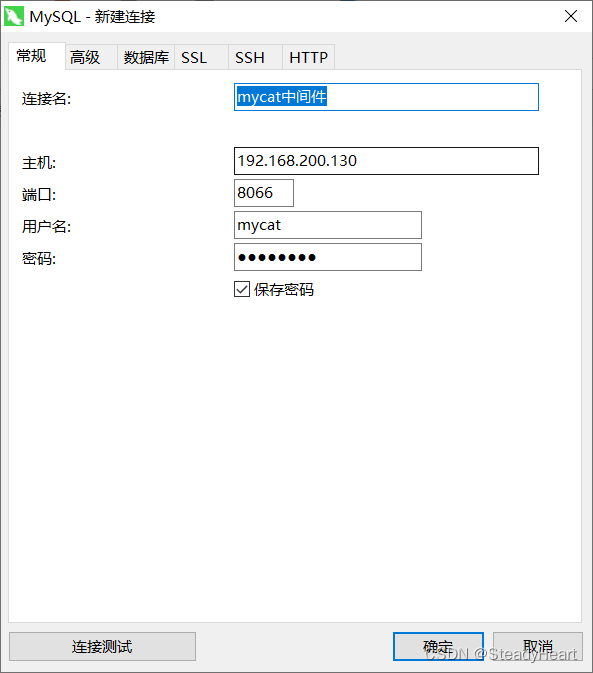
可以看到test_db这个逻辑数据库:
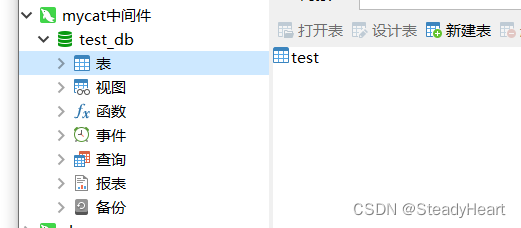
5.2连接主库
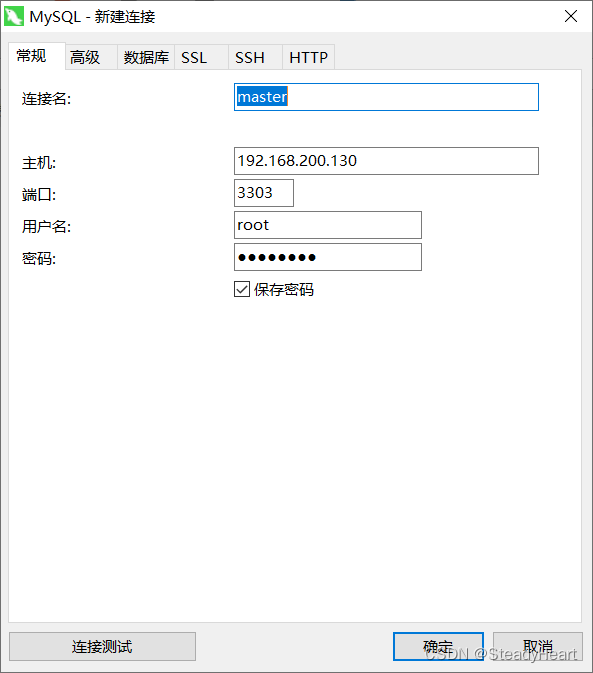
在主库中创建test_db数据库
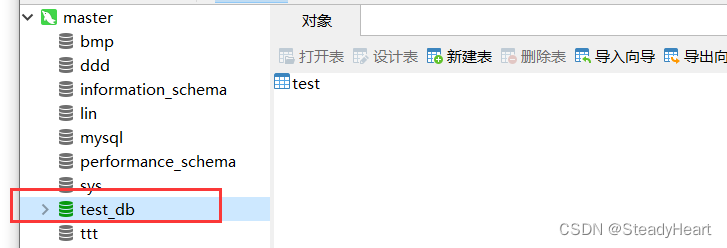
这个test_db就是schema.xml文件中配置的 <dataNode name="dn1" dataHost="masterhost" database="test_db"/>
5.3在mycat中间件中的test_db数据库中,创建表test
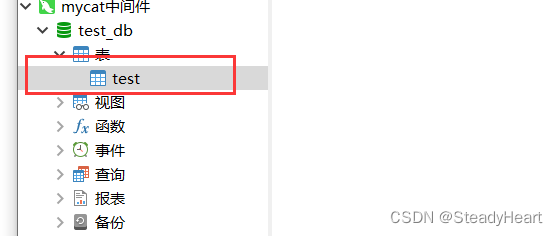
5.4可以看到主库中的test_db数据库中,自动更新了test表
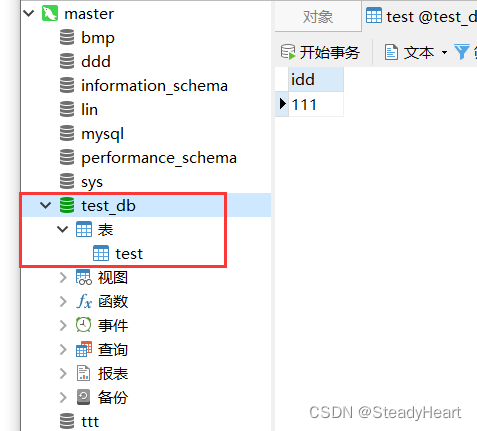
做到这就完成了。
参考:https://blog.csdn.net/weixin_52938172/article/details/124737727

